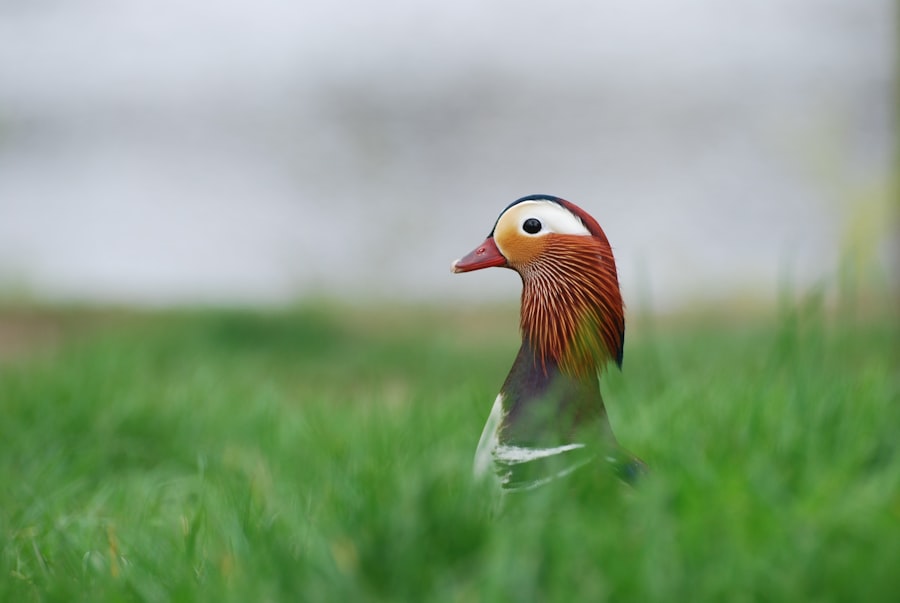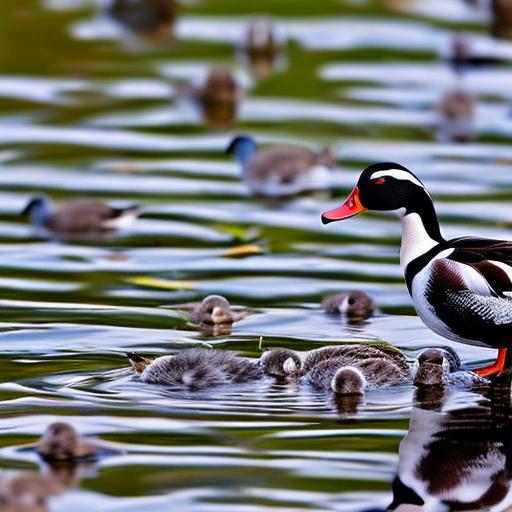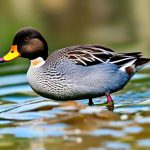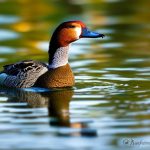North America is home to a variety of black and white duck breeds that have become an integral part of the poultry industry. These breeds are known for their distinctive coloration and are highly valued for their meat and eggs. Black and white duck breeds are not only popular among farmers and breeders, but they also hold historical significance in the region. In this article, we will explore the physical characteristics, history, popularity, breeding and raising practices, health and care, culinary uses, conservation efforts, and future prospects of black and white duck breeds in North America.
Key Takeaways
- North America has a variety of black and white duck breeds, each with unique physical characteristics and histories.
- Black and white duck breeds are known for their striking plumage and are popular among breeders and backyard farmers.
- Many black and white duck breeds have been developed in North America, including the popular Cayuga and Magpie breeds.
- Male and female black and white duck breeds can differ in size and coloration, with males often having more vibrant plumage.
- Breeding and raising black and white duck breeds requires proper care and attention to their health and well-being.
- Black and white duck breeds are versatile in the kitchen and can be used for meat, eggs, and even as pets.
- Conservation efforts are underway to protect and preserve black and white duck breeds, which are at risk of declining populations.
- The future of black and white duck breeds in North America looks promising, with continued interest and support from breeders and enthusiasts.
Physical characteristics of black and white duck breeds
Black and white duck breeds are characterized by their striking coloration, with black feathers on their bodies and white feathers on their wings. They typically have a medium-sized body with a rounded shape. Their bills are usually yellow or orange in color, and their legs are short and stout. These ducks have a smooth plumage that is water-resistant, allowing them to swim easily.
There are several different black and white duck breeds in North America, each with its own unique physical traits. The Cayuga duck is known for its iridescent green-black feathers that shimmer in the sunlight. The Magpie duck has a distinct pattern of black and white markings on its body, resembling a magpie bird. The Welsh Harlequin duck has a silver-white plumage with black spots on its back.
History and origin of black and white duck breeds in North America
Black and white duck breeds were introduced to North America during the 19th century. The Cayuga duck is believed to have originated from wild ducks found in the Cayuga Lake region of New York. It was first recognized as a distinct breed in 1874. The Magpie duck is thought to have been developed in England and was brought to the United States in the early 20th century. The Welsh Harlequin duck is a relatively new breed, developed in Wales in the 1940s and introduced to North America in the 1960s.
These black and white duck breeds have a rich history in North America. They were initially bred for their meat and eggs, as they are known for their flavorful meat and high egg production. In addition, their striking coloration made them popular as ornamental ducks. Over the years, these breeds have become an important part of the poultry industry and are highly valued by farmers and breeders.
Popular black and white duck breeds in North America
There are several popular black and white duck breeds in North America, each with its own unique characteristics. The Cayuga duck is one of the most popular breeds, known for its beautiful green-black feathers and excellent meat quality. It is also a good layer, producing around 100-150 eggs per year.
The Magpie duck is another popular breed, prized for its striking black and white markings. It is a dual-purpose breed, meaning it is suitable for both meat and egg production. Magpie ducks are known for their calm and friendly temperament, making them a favorite among backyard duck enthusiasts.
The Welsh Harlequin duck is gaining popularity in North America due to its attractive silver-white plumage with black spots. It is a lightweight breed that is known for its excellent egg-laying abilities, producing around 250-300 eggs per year. Welsh Harlequin ducks are also known for their docile nature, making them easy to handle and care for.
The popularity of black and white duck breeds varies among different regions in North America. For example, the Cayuga duck is more commonly found in the northeastern United States, while the Magpie duck is popular in the Midwest. The Welsh Harlequin duck is gaining popularity across the country due to its unique appearance and high egg production.
Differences between male and female black and white duck breeds
Male and female black and white duck breeds have some distinct physical and behavioral differences. In terms of physical characteristics, males are usually larger in size than females. They have a more pronounced curl in their tail feathers and a larger, more colorful bill. Females, on the other hand, have a more streamlined body shape and a smaller bill.
Behaviorally, males tend to be more vocal and aggressive than females. During the breeding season, males may engage in territorial displays and fight with other males to establish dominance. Females, on the other hand, are generally quieter and more focused on nesting and caring for their young.
Breeding and raising black and white duck breeds

Breeding black and white duck breeds requires careful selection of breeding stock to ensure the desired traits are passed on to the offspring. It is important to choose healthy ducks with good conformation and strong genetic traits. Breeding should be done with the goal of improving the breed’s overall quality and maintaining genetic diversity.
Raising black and white duck breeds requires providing them with a suitable environment that meets their specific needs. They should have access to clean water for swimming, as well as a secure shelter for protection from predators and extreme weather conditions. A balanced diet that includes a mix of grains, vegetables, and protein sources is essential for their health and growth.
Health and care for black and white duck breeds
Black and white duck breeds are generally hardy and resistant to many common poultry diseases. However, they can still be susceptible to certain health issues if not properly cared for. Common health issues in ducks include respiratory infections, parasites, and foot problems.
To prevent these health issues, it is important to provide ducks with a clean and dry living environment. Regular cleaning of their housing and providing fresh bedding will help prevent the buildup of bacteria or parasites. Ducks should also have access to clean water for drinking and swimming, as well as a balanced diet to ensure they receive all the necessary nutrients.
Culinary uses for black and white duck breeds
Black and white duck breeds are highly valued for their meat, which is known for its rich flavor and tender texture. Duck meat is versatile and can be used in a variety of dishes, from classic roast duck to duck confit and duck stir-fry. The skin of black and white ducks is also prized for its crispy texture when cooked.
Different cooking methods can be used to prepare duck meat, depending on the desired outcome. Roasting is a popular method that results in a crispy skin and tender meat. Confit is another traditional method where the duck is slow-cooked in its own fat, resulting in a flavorful and tender dish. Duck breasts can also be pan-seared or grilled for a quick and delicious meal.
Conservation efforts for black and white duck breeds
Conservation efforts are important to preserve the genetic diversity of black and white duck breeds in North America. These breeds have historical significance and play an important role in the poultry industry. The Livestock Conservancy, a non-profit organization dedicated to preserving rare and endangered livestock breeds, recognizes the importance of conserving black and white duck breeds.
Conservation efforts include maintaining breeding programs that focus on preserving the genetic traits of these breeds. This involves careful selection of breeding stock and promoting responsible breeding practices. It also involves raising awareness about the value of these breeds and encouraging their continued use in agriculture.
Future prospects for black and white duck breeds in North America
The future prospects for black and white duck breeds in North America are promising, but there are also challenges that need to be addressed. The increasing demand for locally sourced and sustainable food has led to a renewed interest in heritage breeds like black and white ducks. Their unique coloration, flavorful meat, and high egg production make them attractive to farmers and consumers alike.
However, there are challenges that need to be overcome to ensure the long-term viability of these breeds. One challenge is the loss of genetic diversity due to the dominance of commercial duck breeds. Continued research and conservation efforts are needed to preserve the genetic traits of black and white duck breeds and prevent them from becoming extinct.
In conclusion, black and white duck breeds have a rich history and play an important role in the poultry industry in North America. Their distinctive coloration, flavorful meat, and high egg production make them highly valued by farmers and consumers. Conservation efforts are important to preserve the genetic diversity of these breeds and ensure their future viability. Continued research and education are needed to promote the use of black and white duck breeds in agriculture and raise awareness about their value.
If you’re interested in learning more about North American black and white duck breeds, you might find this article on the Poultry Wizard website fascinating. It discusses the various factors to consider when designing the floor of a chicken coop, which can also be applicable to duck housing. Understanding the importance of a well-designed coop floor is crucial for providing a comfortable and hygienic environment for your ducks. Check out the article here to gain valuable insights into creating the perfect living space for your feathered friends.
FAQs
What are North American black and white duck breeds?
North American black and white duck breeds are domesticated ducks that are primarily black and white in color and are native to North America.
What are some examples of North American black and white duck breeds?
Some examples of North American black and white duck breeds include the Magpie duck, the Cayuga duck, and the Welsh Harlequin duck.
What is the Magpie duck?
The Magpie duck is a breed of domesticated duck that is primarily black and white in color. It is known for its friendly and docile temperament and is often kept as a pet.
What is the Cayuga duck?
The Cayuga duck is a breed of domesticated duck that is primarily black in color with iridescent green and purple feathers. It is known for its hardiness and adaptability to different environments.
What is the Welsh Harlequin duck?
The Welsh Harlequin duck is a breed of domesticated duck that is primarily white in color with black spots. It is known for its excellent egg-laying abilities and calm temperament.
What are some common uses for North American black and white duck breeds?
North American black and white duck breeds are commonly kept as pets, used for egg production, and used for meat production. They are also sometimes used for exhibition purposes.
Meet Walter, the feathered-friend fanatic of Florida! Nestled in the sunshine state, Walter struts through life with his feathered companions, clucking his way to happiness. With a coop that’s fancier than a five-star hotel, he’s the Don Juan of the chicken world. When he’s not teaching his hens to do the cha-cha, you’ll find him in a heated debate with his prized rooster, Sir Clucks-a-Lot. Walter’s poultry passion is no yolk; he’s the sunny-side-up guy you never knew you needed in your flock of friends!







